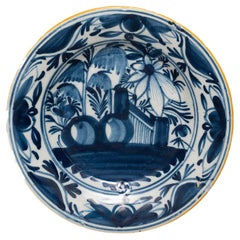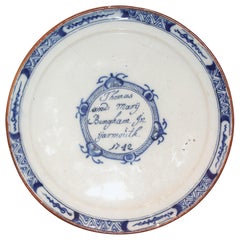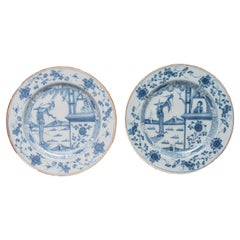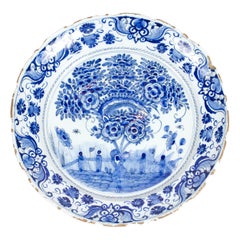18th Century and Earlier Delft and Faience
to
29
430
430
234
228
1
84
91
22
16
1
2
9
4
23
6
3
4
62
56
22
10
5
3
2
428
386
258
215
18
230
196
394
281
45
35
35
430
430
430
121
13
7
6
6
Period: 18th Century and Earlier
Plate delftware Dutch blue white yellow diameter 23cm 9" Chinoiserie landscape
Located in BUNGAY, SUFFOLK
Bold fluid decoration with abundant imagery associated with early Dutch pieces.
Profusely painted with a chinoiserie garden scene with bold foliage and sprays. The rim painted wi...
Category
Dutch Chinoiserie Antique 18th Century and Earlier Delft and Faience
Materials
Earthenware
Plate, Delftware, 1742, Dutch, Thomas and Mary Bingham, Yarmouth, 1742, Suffolk
Located in BUNGAY, SUFFOLK
The inside centre decorated with the inscription, “Thomas and Mary Bingham In Yarmouth 1742”, inside a medallion. The rim decorated with six artemisia leaf reserves, with trellis borders interposed. The rim brown. Restoration to a rim glaze chip. Decorated in blue on a white glaze. Probably Dutch, second quarter of the 18th century.
Provenance: Thomas Bingham was christened in Great Yarmouth, Norfolk, on November 14, 1697. Thomas Bingham married Mary Dent at Woodbridge in Suffolk on 24th August, 1721. Thomas and Mary Bingham had a daughter Ann christened in Yarmouth on December 17, 1727. Thomas Bingham was buried in Great Yarmouth on July 6, 1774. Thomas, a son of Thomas and Mary Bingham, was christened in St. John Maddermarket, Norwich, on December 3, 1775.
In the Universal British Directory of 1793-8, Woodbridge is described as a maritime town situated near the River Deben on the turnpike road leading from London to Yarmouth. It is about 77 miles from London and as Great Yarmouth is 123 miles from London, the distance by road between the two places is about 50 miles. The River Deben, on which the town is situated, is stated to have been navigable up to the town where there were two quays. There is no-one named Bingham listed in Woodbridge in the entry for the town in the Universal British Directory.
In the printed Freemen of Yarmouth, a John Bingham is the only entry under the surname. He became a freeman in 1721, having been an apprentice of John Cooper. There is no mention of the surname in the three volume Perlustration of Great Yarmouth by C J Palmer...
Category
Dutch Baroque Antique 18th Century and Earlier Delft and Faience
Materials
Earthenware
Plates pair delftware English Liverpool blue white chinoiserie tall lady
Located in BUNGAY, SUFFOLK
Delightful pair of chinoiserie plates evoking how exotic the East appeared to Europe and a sense of wonder it portrayed.
Painted with a chinoiserie scene of a tall lady standing i...
Category
English Chinoiserie Antique 18th Century and Earlier Delft and Faience
Materials
Earthenware
Nice Delft Fan Dish by Geertruy Verstelle
By Geertruy Verstelle
Located in Montreal, QC
Delft Fan dish with florals motives displayed like a peacock.
Signature G.V.S is for Geertruy Verstelle, a Woman Faience Manufacturer Established at Delft in...
Category
Dutch Antique 18th Century and Earlier Delft and Faience
Materials
Ceramic
Plate delft London Chinoiserie landscape blue white pottery diameter 22.5cm 9"
Located in BUNGAY, SUFFOLK
A rare early example of European chinoiserie decoration showing how minimal the decoration was similar to abstraction.
Painted with a chinoiserie landscape scene with a fence and ga...
Category
English Chinoiserie Antique 18th Century and Earlier Delft and Faience
Materials
Earthenware
Dish Charger delftware Dutch Chinoiserie blue white diameter 30cm 12"
Located in BUNGAY, SUFFOLK
Beautiful, early stylised decoration evoking the striking simplicity of early Chinoiserie painting
Painted with a central floral spray within a circle centre, surrounded by a trai...
Category
Dutch Chinoiserie Antique 18th Century and Earlier Delft and Faience
Materials
Earthenware
Plates Pair Biancosoprabianco Delft Redcliff Back Bristol Chinoiserie Polychrome
Located in BUNGAY, SUFFOLK
Charming pair of plates with rare and desirable features of delftware; fluting, bianco-sopra-bianco border and in polychrome including manganese
From a Bristol collection and originally made in Bristol
Pair of 18th century bianco-sopra-bianco delftware plates, made at Redcliff Back, under Richard Frank. The press-moulded fluted border and scalloped rim is decorated with repeated foliate designs in a style known as ‘bianco sopra bianco‘, or ‘white on white’. Although inspired by the incised patterns found on the rims of Chinese export porcelain, the name alludes to the use of this decoration on sixteenth-century Italian maiolica at Faenza.
The main pattern depicts an oriental river scene, showing two hatted men...
Category
English Baroque Antique 18th Century and Earlier Delft and Faience
Materials
Pottery
Plate Delftware, Inscribed 1744, Dutch, Great Yarmouth, Blue and White, Herring
Located in BUNGAY, SUFFOLK
The inside centre decorated with the inscription, “Great Yarmouth 1744”, surrounding the blazon of the arms of the town (three lions passant guardant in...
Category
Dutch Baroque Antique 18th Century and Earlier Delft and Faience
Materials
Earthenware
Antique 18th Century Delft Porcelain Plate
Located in New Orleans, LA
Antique 18th century Delft porcelain plate.
Category
Dutch Antique 18th Century and Earlier Delft and Faience
Materials
Porcelain
18th Century Delft Charger
Located in Dallas, TX
Delft Charger from the 18th century.
Category
Antique 18th Century and Earlier Delft and Faience
Recently Viewed
View AllMore Ways To Browse
Manganese Delft
Quimper Set
Delft Chargers Pair
Royal Delftware
Faience Dog
Antique Delft Tobacco Jar
Delft Windmill
Large Delft Platter
Antique Silver Shaving
18th Century Tobacco Jar
Delft Tulip
16th Century Delftware
Chinoiserie Tile
Delft Blue Jug
Antique English Delft Ceramics
Delft Jardiniere
Delft Polychrome Charger
Delft Ware





